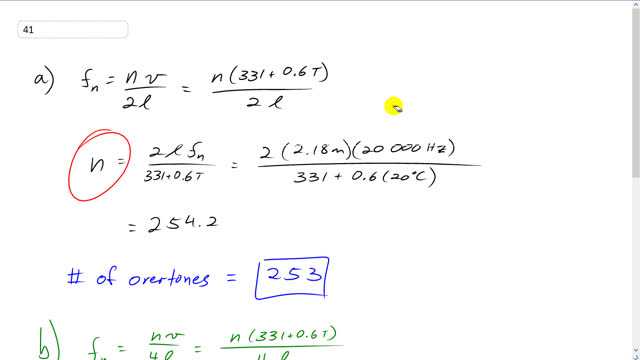
How many overtones are present within the audible range for a 2.18-m-long organ pipe at
- if it is open, and
- if it is closed?

In order to watch this solution you need to have a subscription.
This is Giancoli Answers with Mr. Dychko. We need to figure out what the integer n is for the highest possible frequency within the audible range and that highest frequency is 20,000 hertz for a normal ear. And if it's an open tube, that means the nth harmonic is going to be n times the wave speed divided by 2 times the length of the tube. And the wave speed is 331 plus 0.6 times the temperature in Celsius and we could solve for n by multiplying this by 2 l over 331 plus 0.6 T and doing the same on this side. So, n equals 2 l times fn divided by 331 plus 0.6 T so, it's 2 times 2.18 meters times 20,000 hertz divided by 331 plus 0.6 times twenty degrees Celsius which is 254.2. So, there's 254 harmonics. And then since it asks for the number of overtones, this is everything, this is all the number of harmonics not including the fundamental. So, that means it's 254 minus 1 which is 253. And if we assume it's a closed end tube. So, open only at one end but close at the other, the nth harmonic is nv over 4 l. And we'll solve for n again. Exactly the same formulas above except the number 4 instead of 2 here and we get 508.45. Now, n must be odd for a closed tube. So, n equals 1, 3, 5, 7 and so on. So, that means the largest n possible that's less than 508.45 is 507. And the number of overtones will be this 507 minus 1 for the harmonic. And then divided by 2. Because if n is 3, that means there are only two harmonics. And if n is 5, that means there's 3 harmonics. Or you could say that there's two overtones so, just to get you give you a sense of why this is right, let's look at the pattern here. We have, if we have 5 minus 1 for the fundamental divided by 2, that's 4 over 2 which is 2. 2 overtones and that's true, we can see that there's a 3 and then there's a 5, overtone corresponding to n3, the other one corresponding to n5. So, and likewise over here, 507 minus 1 over 2, tells us there are 253 overtones.